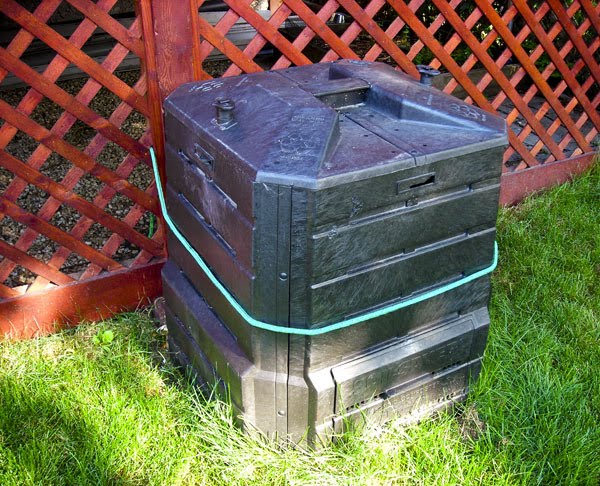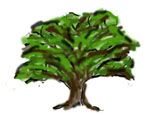Composting, if you have a space for a pile or a bin, is easier – and less smelly – than you might think. I have a compost bin that lives on the ground up against the lattice work for the raised deck in the back yard:
Isn’t it lovely? I think so.
As you can see I have a bungee cord around it because I didn’t want the dog tipping it over. Dogs will eat compost and food on its way to becoming compost. And no one wants that. Well, except maybe the dog, but she doesn’t get a vote.
I discovered that the process is simpler than I thought, and the method in this house goes something like this: when we have food scraps, we put them in a compost bucket under the sink. Said food scraps can include peelings or stems or other inedible parts of fruits or veggies as well as food that’s about to go bad. I use this compost bucket from gaiam.com. It has a carbon filter at the top to prevent any smells, and I have to say it works well. I surely would hear about it a lot if it didn’t. All of this type of material is called green material, by the way, and we’ll get back to that later.
Once a week or so, we empty the bucket into the compost bin in the yard and dampen the contents with the garden hose. We’re aiming for the moisture level of a wrung-out sponge.
Just about all of our yard waste can go in there as well – fallen leaves, dead plants, clippings, small sticks, etc. Cardboard and shreddings from the paper shredder can go in also. I’d like to see an identity thief paw through sensitive, shredded financial information in a compost bin – talk about a disincentive, eh? Dried grass clippings can be used as well, but overdoing it leads to a stinky mess and our lawnmower is just a human-powered push mower, so we tend to leave the clippings on the lawn. I also avoid adding any seeds, weeds, or diseased plants as they will grow in your pile and possibly take it over. All of this type of material is known as brown material, and ideally you have a balance of green and brown. I don’t particularly worry about a balance myself as part of my goal is reducing waste and I don’t want to toss out one or the other in the name of balance, although I do know that better compost is made with a balance. I certainly make sure there’s enough brown material, as having too much green is what can lead to bad smells. You are letting food rot, after all. It’s not the prettiest process in the world.
Any material in there will compost faster if it’s not large but I tend to let large pieces such as corn cobs just do their thing. They get there eventually. I will also turn the compost as well, usually when I’m adding any material. You can buy a special tool for that, but I use the pitchfork the previous owners of the house kindly left in our yard instead. On occasion, I sprinkle in some compost activator although this is entirely optional, as the material will compost without it. It did speed up the initial process, however, and if you’re eager to have compost you can use, it’s a good way to go. So, in about two months after I first started this process, I had some nice black soil at the bottom, which I removed by opening the door at the bottom of the bin and shoveling it out. I can add it on top of the soil or mix it in; either way, the garden loves it.
Other people use a pile and occasionally build their own enclosure with 2x4s and wire. Some buy a bin you can spin, such as this one. It means you don’t have to use a tool to turn it, but they do tend to hold less than my bin. Some people, particularly those who are short on space, use vermicomposting with worms in small plastic bins. I don’t have any experience with that but it can be a great solution for an apartment dweller. Perhaps you should check your lease for a pet clause, just in case. 😉
You can compost things you might not have believed would compost. Used teabags and coffee grounds add a lot of nutrients to a compost pile or bin. But you can also add dryer lint (if your clothes are not made of synthetic fibers) and clean hair clippings or those pet hair tumbleweeds you find in your house. Or maybe that’s just our house. Anyway, here is an interesting list of uncommon items you can add to a compost bin.
But what should you NOT add? You shouldn’t add meat, dairy, eggs (though the shells are fine), or oily/fatty foods. Meat, dairy, and eggs attract rodents and oily foods slow the process down too much. You also shouldn’t add any excrement from predators, including your dog or your cat. Or yourself, even if you’re vegetarian. 😉 If you have rabbits or herbivore-only chickens, theirs is probably okay to add. But meat eaters and vegetarian humans can carry pathogens and the heat from the compost process may not kill those pathogens.
We don’t eat much meat in this house, but we do have dairy and eggs and food cooked in oil. My next experiment will probably come from trying an air-tight Bokashi All-Food composter. You can put any food at all in that, but it doesn’t finish it and produce actual compost. It produces pickled remains that you can bury in your compost pile or bin and an acidic liquid that you must periodically drain out. You can use the liquid to clear out your drains or dilute it heavily (a ratio of about 100:1 water to bokashi liquid) to fertilize your plants. I’ll certainly update after I’ve seen the results. If I can get it to work, it would potentially mean throwing out zero food scraps, and that to me is a worthy goal.
And if you prefer a visual guide, here’s a youtube video from the head gardener at Oak Park’s own Cheney Mansion. It really shows you how easy this can be, more so than a list of steps. Happy composting!
[youtube=http://www.youtube.com/watch?v=5IZp5EsHAW4&hl=en_US&fs=1&]





